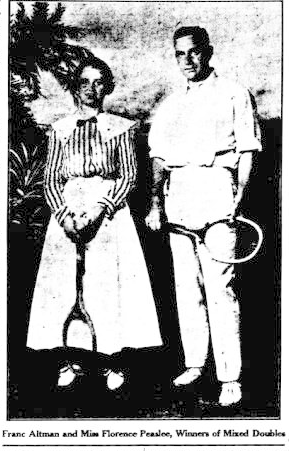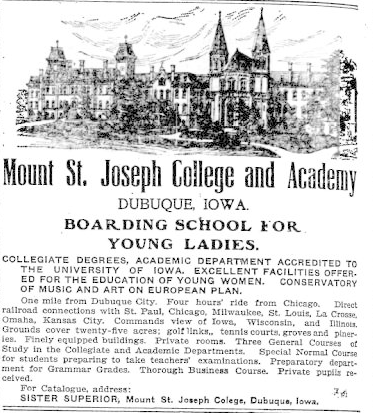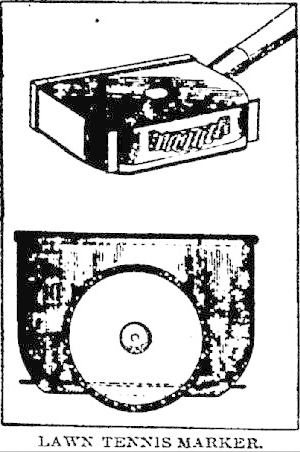Encyclopedia Dubuque
"Encyclopedia Dubuque is the online authority for all things Dubuque, written by the people who know the city best.”
Marshall Cohen—researcher and producer, CNN
Affiliated with the Local History Network of the State Historical Society of Iowa, and the Iowa Museum Association.
TENNIS COURTS: Difference between revisions
No edit summary |
No edit summary |
||
| Line 22: | Line 22: | ||
[[Image:tennis2.png|left|thumb|250px|(1906) Lawn tennis marker. Photo courtesy: Telegraph Herald]]Playing lawn tennis involved, among other details, marking boundaries clearly. Tapes, which were often used, proved a nuisance, and could not compare with lines marked with lime directly upon the grass. An invention which proved popular was a box of light metal mounted on wheels with a hinged lid. Filled with powdered lime, the machine was carried to the site of the proposed line and then pushed along a line. As the wheel rotated, corrugations drew out the powder. (10) | [[Image:tennis2.png|left|thumb|250px|(1906) Lawn tennis marker. Photo courtesy: Telegraph Herald]]Playing lawn tennis involved, among other details, marking boundaries clearly. Tapes, which were often used, proved a nuisance, and could not compare with lines marked with lime directly upon the grass. An invention which proved popular was a box of light metal mounted on wheels with a hinged lid. Filled with powdered lime, the machine was carried to the site of the proposed line and then pushed along a line. As the wheel rotated, corrugations drew out the powder. (10) | ||
By 1914 the popularity of tennis of tennis in Dubuque was well established. In that year through the generosity of Judge [[SHIRAS, Oliver | By 1914 the popularity of tennis of tennis in Dubuque was well established. In that year through the generosity of Judge [[SHIRAS, Oliver Perry|Oliver Perry SHIRAS]] a tennis court was constructed at [[EAGLE POINT PARK]]. This drew such attention, at one time thirty-two people was waiting to play, that a second was built and a plan was placed before the park board for two more. The acceptance of the plans led to the announcement that all would be ready in 1915. This seemed insufficient to many observers. The City of Spokane, Washington it was found had twenty-three courts. With three times the population of Dubuque, the comparison was made that Dubuque should have at least eight. (11) | ||
The only other tennis courts were three at the [[DUBUQUE GOLF AND COUNTRY CLUB]]. Membership at the club was described as expensive, and even members had to pay an addition $5.00 annually (adjusted for inflation equal to $125.62 in 2019) to use them. if funds could be found four places downtown were suggested: the foot of Hodgdon Avenue located on West Locust west of [[JACKSON ELEMENTARY SCHOOL]], on city-owned ground on the corner of Dodge and Booth, on Hill Street near Caledonia, and on Julien Avenue. (12) | The only other tennis courts were three at the [[DUBUQUE GOLF AND COUNTRY CLUB]]. Membership at the club was described as expensive, and even members had to pay an addition $5.00 annually (adjusted for inflation equal to $125.62 in 2019) to use them. if funds could be found four places downtown were suggested: the foot of Hodgdon Avenue located on West Locust west of [[JACKSON ELEMENTARY SCHOOL]], on city-owned ground on the corner of Dodge and Booth, on Hill Street near Caledonia, and on Julien Avenue. (12) In 1915 the establishment of [[CLEVELAND PARK]], a three acre tract from Cleveland Avenue to within one hundred feet of Dodge Street, came with the announcement that the land would be used in part for the construction of one and possibly two tennis courts. (13) | ||
The pressure to add additional courts to the city was increased by the organization of the Dubuque Tennis Association in June, 1916. Officers included [[ALTMAN, Franc K.|Franc K. ALTMAN]], president; [[FITZPATRICK, C. E.|C. E. FITZPATRICK]], vice-president; and [[MOLO, Harold|Harold MOLO]], treasurer. Organized to bring amateur players of the city together, the first city tennis tournament sponsored by the association was held in July. First place winners received silver loving cups while those finishing second received rackets and other tennis supplies donated by area businessmen. The plan was to make the city tournament an annual event growing larger each year from the initial 105 entries in the first tournament. | The pressure to add additional courts to the city was increased by the organization of the Dubuque Tennis Association in June, 1916. Officers included [[ALTMAN, Franc K.|Franc K. ALTMAN]], president; [[FITZPATRICK, C. E.|C. E. FITZPATRICK]], vice-president; and [[MOLO, Harold|Harold MOLO]], treasurer. Organized to bring amateur players of the city together, the first city tennis tournament sponsored by the association was held in July. First place winners received silver loving cups while those finishing second received rackets and other tennis supplies donated by area businessmen. The plan was to make the city tournament an annual event growing larger each year from the initial 105 entries in the first tournament. (14) | ||
| Line 56: | Line 56: | ||
12. Ibid. | 12. Ibid. | ||
13. "Name is "Cleveland Park," ''Dubuque Telegraph-Herald'', October 15, 1915, p. 31 | |||
14. "City Tournament Brings the Best Amateur Tennis Players of the City Into a Struggle for Honors on the Public Courts," ''The Telegraph-Herald'', July 23 1916, p. 11 | |||
Revision as of 02:23, 23 January 2020
Being researched
TENNIS COURTS. The earliest example of the private ownership of a tennis court relates to the daughter of one of Dubuque premier industrialists. Mary Ellen Cooper, the daughter of Augustin A. COOPER, married John Robert WALLER on January 24, 1878. As a wedding gift, A. A. Cooper offered the couple one of the prime lots in a block he owned south of WASHINGTON PARK. (1) The Wallers constructed the home they called YORK (THE) as an English estate complete with tennis courts, fishpond, orchard and conservatory. The residence was a popular site for teas and parties hosted for the English families of Dubuque. (2) With the death of her husband, Mary Ellen sold the property to move closer to her sister in Maryland. Russell Mulgrew sold the York to Joseph J. NAGLE who sold the estate to the United States Treasury as the site for the new post office. (3)
In 1887 of the three tennis courts in some stage of completion, only one fully laid out. It was located in the upper end of the baseball park with a wire fence constructed to keep cattle from intruding. There was enough interest in the city to form a tennis club. (4)
Tennis was also among the improvements brought to residents of SHAWONDASEE. In 1895 in addition to improvements to the cottages owned by such well-known Dubuque residents as Poole, Orrick, and Deming and the construction of a new water system, two fine tennis courts were constructed. (5)
As plans were being completed for the club house at the new "golf club," a committee in 1900 was already surveying the grounds for ways of making the site better. In addition to the "links," the placement of tennis courts was being discussed. (6) A report noted in May, 1900 that "the membership includes the prominent people of the city and the money to make all the necessary improvements has already been secured. (7)
Officials of the Y. M. C. A. Athletic Park announced the rapid completion of work at the site and a quick opening in May, 1900. Along with a running track; remodeled club house with the installation of lockers, dressers, and shower; new tennis courts were being constructed. It was expected that the many "tennis fiends" in the community would give the courts their full attention. "The ladies of the city will probably be admitted free to the park to play tennis." (8)
Weeds in tennis courts or on walks or drives posed problems for those in charge of such pests in 1903. The remedy was:
About the best method that has been devised is to kill them with
some effective solution having either an arsenic, sulphuric acid,
carbolic acid or sal-soda base. Any one of these is effective,
though the arsenic mixtures, some of which are offered as
commercial proprietary solutions, are the most persistent it
their effects. (9)
Playing lawn tennis involved, among other details, marking boundaries clearly. Tapes, which were often used, proved a nuisance, and could not compare with lines marked with lime directly upon the grass. An invention which proved popular was a box of light metal mounted on wheels with a hinged lid. Filled with powdered lime, the machine was carried to the site of the proposed line and then pushed along a line. As the wheel rotated, corrugations drew out the powder. (10)
By 1914 the popularity of tennis of tennis in Dubuque was well established. In that year through the generosity of Judge Oliver Perry SHIRAS a tennis court was constructed at EAGLE POINT PARK. This drew such attention, at one time thirty-two people was waiting to play, that a second was built and a plan was placed before the park board for two more. The acceptance of the plans led to the announcement that all would be ready in 1915. This seemed insufficient to many observers. The City of Spokane, Washington it was found had twenty-three courts. With three times the population of Dubuque, the comparison was made that Dubuque should have at least eight. (11)
The only other tennis courts were three at the DUBUQUE GOLF AND COUNTRY CLUB. Membership at the club was described as expensive, and even members had to pay an addition $5.00 annually (adjusted for inflation equal to $125.62 in 2019) to use them. if funds could be found four places downtown were suggested: the foot of Hodgdon Avenue located on West Locust west of JACKSON ELEMENTARY SCHOOL, on city-owned ground on the corner of Dodge and Booth, on Hill Street near Caledonia, and on Julien Avenue. (12) In 1915 the establishment of CLEVELAND PARK, a three acre tract from Cleveland Avenue to within one hundred feet of Dodge Street, came with the announcement that the land would be used in part for the construction of one and possibly two tennis courts. (13)
The pressure to add additional courts to the city was increased by the organization of the Dubuque Tennis Association in June, 1916. Officers included Franc K. ALTMAN, president; C. E. FITZPATRICK, vice-president; and Harold MOLO, treasurer. Organized to bring amateur players of the city together, the first city tennis tournament sponsored by the association was held in July. First place winners received silver loving cups while those finishing second received rackets and other tennis supplies donated by area businessmen. The plan was to make the city tournament an annual event growing larger each year from the initial 105 entries in the first tournament. (14)
---
Source:
1. Friedman, Larry and Fischer, Katherine. A. A. Cooper: Reinvesting the Wheel, River City Press, 2016, p. 91
2. Ibid., p. 92
3. Ibid. p. 93
4. "The Tennis Courts, "The Herald," July 24, 1887, p. 8
5. "In Society," The Dubuque Herald, April 7, 1895, p. 2
6. "The Golf Club House," The Dubuque Herald, March 4, 1900 p. 9
7. "In the Realm of Sport," The Dubuque Herald, May 6, 1900, p. 6
8. "Y. M. C. A. Athletics," The Dubuque Herald, May 5, 1900, p. 5
9. "The Destruction of Weeds," Telegraph-Herald, August 6, 1903, p. 4
10. "Lawn Tennis Marker," Dubuque Telegraph-Herald, Mar. 14, 1906, p 10
11. "Tennis Becomes a Popular Game," Dubuque Telegraph-Herald, October 30, 1914, p. 9
12. Ibid.
13. "Name is "Cleveland Park," Dubuque Telegraph-Herald, October 15, 1915, p. 31
14. "City Tournament Brings the Best Amateur Tennis Players of the City Into a Struggle for Honors on the Public Courts," The Telegraph-Herald, July 23 1916, p. 11




